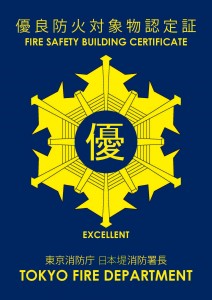- How do I get to the facility from the nearest station?
-
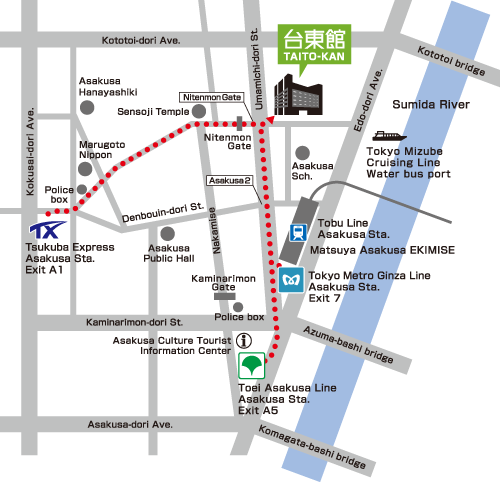
TAITO-KAN is conveniently accessible in six ways.
The closest station is Asakusa Station on the Tokyo Metro Ginza Line and the Tobu Skytree Line.
Go up the stairs at Exit 7 and exit on the left side.
Proceed to the right on Umamichi-dori Ave. Located at the Nitenmon Intersection. 5min on foot.
We are also accessible via the Toei Asakusa Line, Tsukuba Express, Toei Bus and Tokyo Mizube Line (water bus).See here for details.
Access
Area Guide
Facility Information
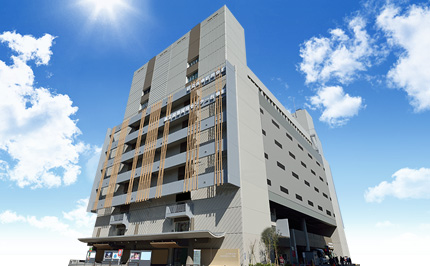
Safe, Reliable Support in an Out-standing Location TAITO-KAN – A Communication Hub for Creating New Business Opportunities
Tokyo Metropolitan Industrial Trade Center Taito, located in Asakusa, one of the leading metropolitan areas for international tourism and culture, serves as a venue for exhibitions, trade fairs, events, seminars, examinations and meetings.
Our facility functions as a base venue for the small and medium-sized businesses that support industry in Tokyo to advertise their businesses market growth, and it contains exhibition halls and meeting rooms usable by a variety of business types. We are sincerely looking forward to your visit.
Floor Guide
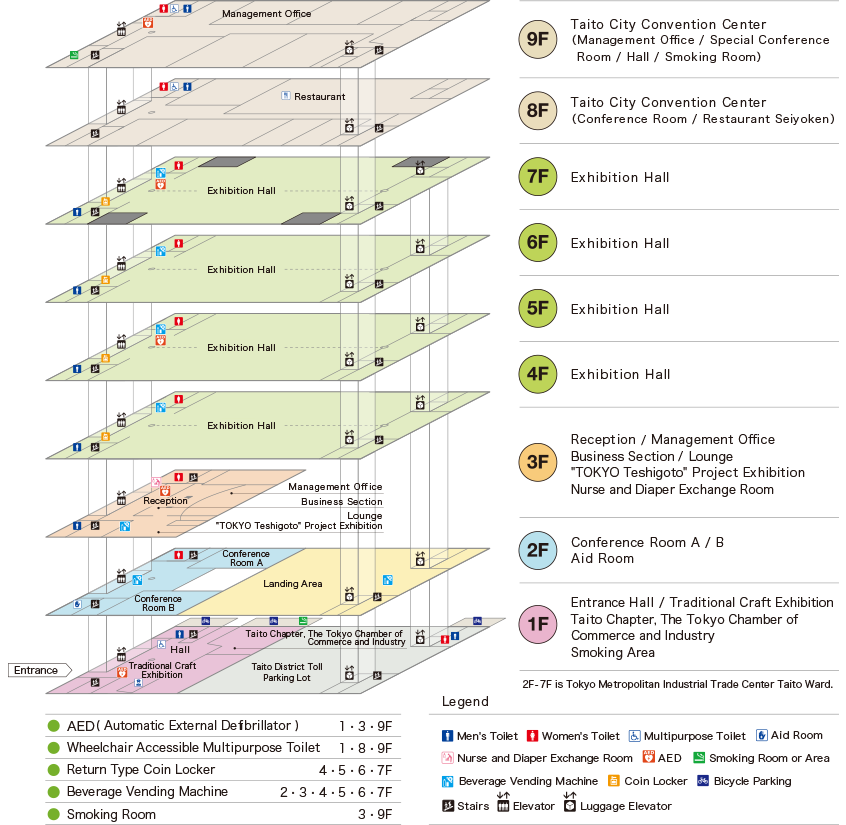
Facility Description
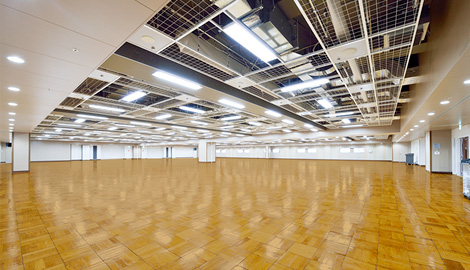
Exhibition Hall (4・5・6・7F)
We offer four 600-person capacity multipurpose halls for a total of 1,400m2 right in the heart of the city where space is at a premium.These are available for a broad range of uses, including exhibitions, trade fairs, events, seminars, recruitment fairs, examinations, art exhibitions and more.
It is also possible to use just the northern or southern half of a hall by using sliding partitions.
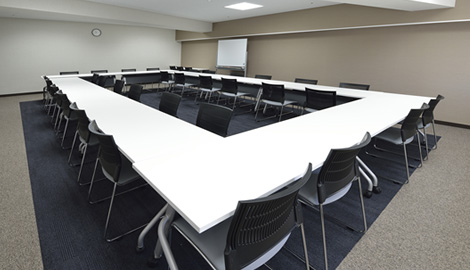
Conference Room (2F)
A 35-person capacity 67.4m2 meeting room.
In addition to holding events, this meeting room is suitable for training sessions and seminars as well as various types of consultations and interviews. The room contains 11 3-person tables and 35 chairs.
1F
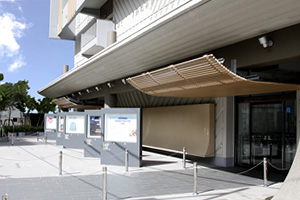
Entrance (1F)
We ask Exhibition Hall users to display information relating to the day of the event in the poster cases located in front of the main entrance.
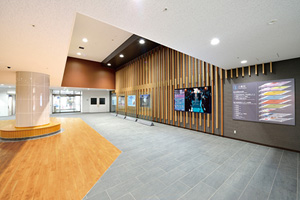
Entrance Hall
Traditional Craft Exhibition (1F)
We welcome visitors providing event information through glass notice boards for posters as well as a digital signboard.
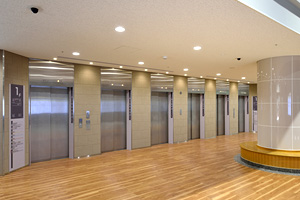
Elevator (1F)
Please make use of our 4 elevators (15-person capacity).
There are also (2) elevators for exclusive use by visitors to Taito District Hall and the restaurant.
2F
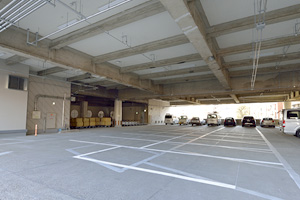
Shipping and Delivery Area (2F)
Accommodation for 35 standard size cars / 2 luggage elevators (2t/3t).
Period of usage to be determined at preliminary adjustment meeting.
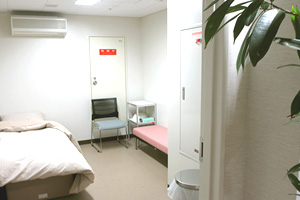
Aid Room (2F)
A bed is available for use by visitors who need to lie down temporarily.
3F
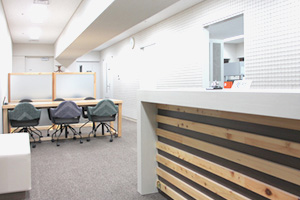
Reception/Management Office (3F)
The general window for the Industrial Trade Center.
We accept various types of applications and consultations.
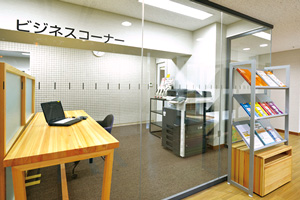
Business Section (3F)
Computers, multifunction machines (printer, copier and fax), mobile phone chargers, etc. are available for use for a fee.
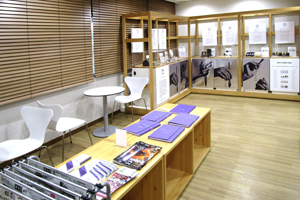
Lounge/"TOKYO Teshigoto" Project Exhibition (3F)
Provides temporary relaxation.
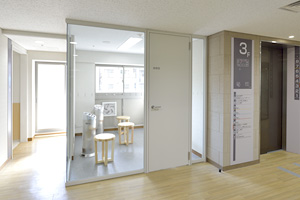
Smoking Room (3F)
Please use the smoking areas located inside the outdoor bicycle parking lot and on the 3F.
Other than these two areas, smoking is prohibited throughout the entire facility.
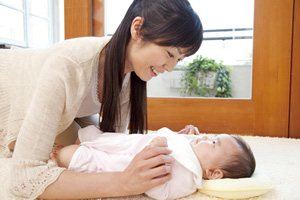
Nursing and Diaper Changing Room (3F)
Enables visitors with small children to nurse and change diapers with peace of mind.
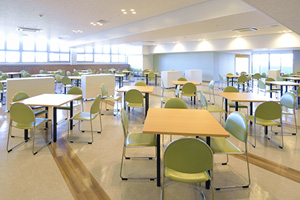
Restaurant (8F)
< Inside the Taito District Hall "Ueno Seiyoken Asakusa Branch" >
Please make use of this scenic restaurant for business talks and meals.

11:00-16:00 (LO 15:00) Closed Mondays
We accept orders for banquets, catering and boxed lunches.
Seats: 144
Inquiries: Ueno Seiyoken, Asakusa Branch;
TEL: +81-3-3842-0771
URL:
http://www.seiyoken.co.jp/restaurant/asakusa/index.html External Link
Facility information
| Rental Exhibition Hall |
|
|---|---|
| Rental Conference Room |
|
| Office/Business Section |
|
| Nursing and Diaper Changing Room |
|
| Lounge |
|
| Smoking Room |
|
| Aid Room |
|
| Shipping and Delivery Area |
|
Equipment Information
| Passenger Elevator | 4 elevators (15-person capacity) and 2 elevators for exclusive use by visitors toTaito District Hall |
|---|---|
| Delivery/ Shipping Luggage Elevator |
2 elevators 2-ton load capacity (one elevator): (W1.7m×H2.4m×D3.0m) B1-2F・4F-10F
3-ton load capacity (one elevator): (W2.0m×H2.6m×D4.15m) 1F-2F・4F-7F
|
| Wheelchair Accessible Toilet | 1・8・9F |
| Public Toilet (Men’s / Women’s) | Located on each floor from 1F-9F |
| AED (Automatic External Defibrillator) |
1・3・9F |
| Diaper Change Stand | Inside 1F Wheelchair Accessible Toilet Inside 3F Nursing and Diaper Changing Room |
| Return Type Coin Locker | 10 units each on 4F-7F |
| Beverage Vending Machine | 2・3・4・5・6・7F Shipping and Delivery Area |
| Mobile Phone Charger | 3・4・6F |
Area Guide
Information on Nearby Facilities
Information on the area around TAITO-KAN.
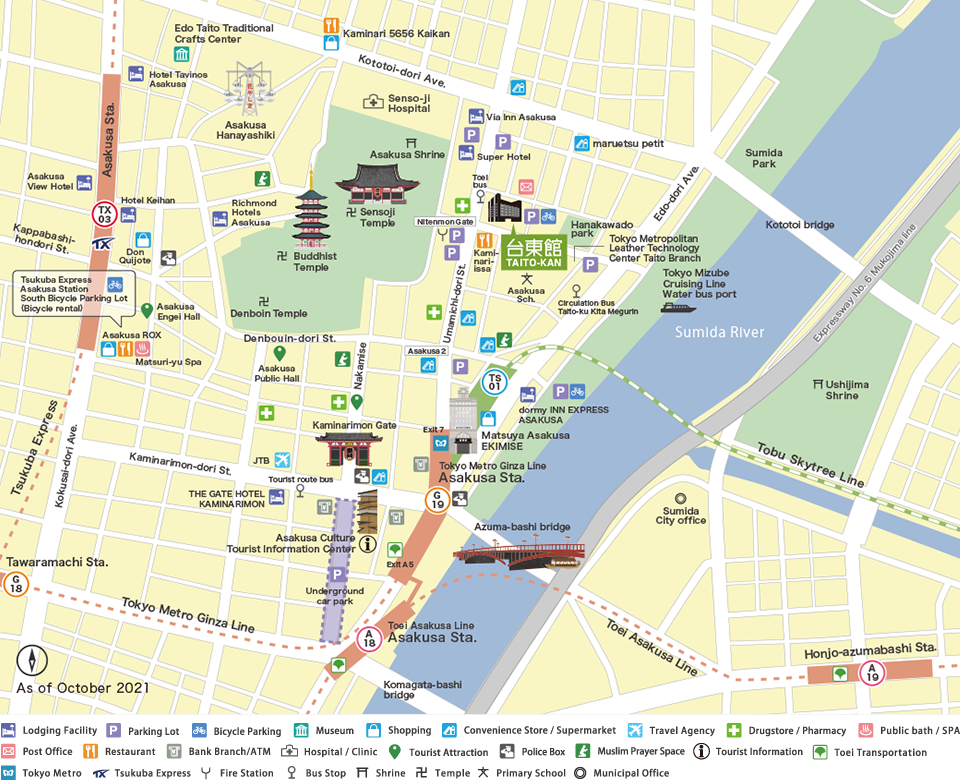
Representative Tourist Attractions
The following are highlights in the Asakusa area where TAITO-KAN is located.
Asakusa is a world-class sightseeing spot that retains aspects of ancient history.
This area is where Edo culture evolved, and traditional commerce and industry, masterful craft skills and that good old Edo atmosphere are all still alive and well.
The surrounding area contains multiple dining, shopping and entertainment facilities.
Sensoji Temple, the oldest in the metropolitan area, Kaminarimon Gate(Furaijinmon), featuring a gigantic red lantern, Nakamise-dori, a shopping district located along the approach to the temple, as well as season events held in the area are always bustling with both domestic and foreign tourists.
There is a fun course in which guests can ride rickshaws, which are rare even in Tokyo, around to Japan’s oldest amusement park, music and performance halls featuring rakugo and kabuki, and other locations.
Please enjoy some of the premium tourist attractions in the city that integrate the old with the new while gazing at the nearby TOKYO SKYTREE®, the world’s tallest stand-alone communication tower.
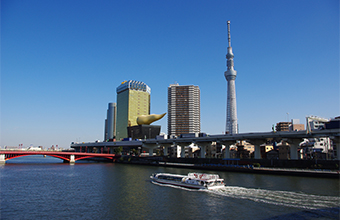
Sumida River
TOKYO has prospered as a “city of water” since the Edo period.
After passing under the famous bridge in Shitamachi, you can see new TOKYO spreading out before you. The waterfronts in TOKYO are full of seasonal flavor.
The numerous, diverse arched bridges seem to be vying with each other in a ‘bridge fair’ to see which is the most unique.
The scenery contains many highlights, including TOKYO SKYTREE® and expansive groups of uniquely designed buildings.
The multitude of cherry blossom trees are considered the best place to view spring cherry blossoms in TOKYO. The Sumida Fireworks Festival, held every summer, is the original fireworks festival in Japan. We also recommend water tours in which you can enjoy the Shitamachi atmosphere while riding houseboats and water buses!
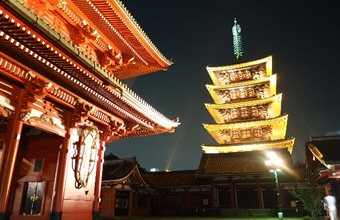
Sensoji Temple
This Asakusa landmark is the oldest temple in TOKYO with
1,400 years of history.
Sensoji Temple is likely the most well-known and familiar temple in TOKYO.
This temple was built in the Asuka period (628), which makes it the oldest temple in the metropolitan area.
The temple receives roughly 30 million domestic and foreign visitors a year, and on memorial service and festival days, it bustles with people praying for luck.
Denboin-dori Street was recently renovated to look like an Edo period towns cape.
At night, the main hall, 5-storied pagoda, Hozomon Gate and Kaminarimon Gate are illuminated, which creates a fantastical sight.
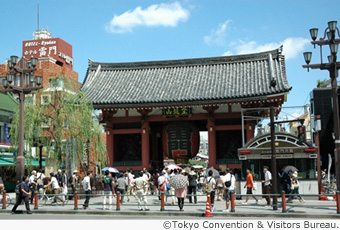
Kaminarimon Gate (Furaijinmon)
The main gate into Sensoji Temple and the symbol of Asakusa.
The gate was constructed in 942.
The sight of the giant 3.9 meter tall red lantern hanging from the vermillion-lacquered temple gate symbolizes Japan, and the powerful images of Fujin, God of the Wind, and Raijin, God of the Thunder, enshrined on the right and left sides have caused many tourists to cry out in admiration.
People first began by praying for eradication of troubles such as environmental damage and fires, but eventually they began to also pray for peace and good harvests.
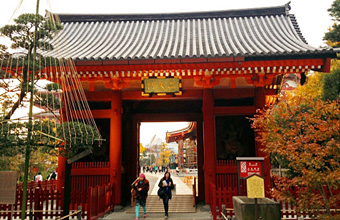
Nitenmon Gate
A gate is to enshrine important cultural property constructed in the Edo period.
Nitenmon Gate is located directly in front of TAITO-KAN.
This vermillion-lacquered gate stands to the east of Sensoji Temple’s main hall, and the current gate was built in 1649.
The structure is valuable as an ancient work of architecture from the early Edo period still remaining within the precincts, and it has been designated as a national important cultural property.
Renovations finished in 2010, and its original splendor has been restored.
It is dedicated to two of the Four Heavenly Kings, and both of these were built using the yosegi-zukuri technique of combining multiple pieces of wood.
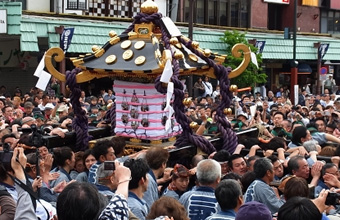
Asakusa Shrine
This shrine is famous for holding Sanja Matsuri, the largest festival in the metropolitan area.
The shrine is located to the right of Sensoji Temple’s main hall. It is commonly referred to as “Sanja-sama.”
The origin of the construction of Sensoji Temple in 628 goes back to the story of two fishermen living near Miyato River (now Sumida River). The fishermen caught a statue in their net, and the ruler of the land, who as a local intellectual, decided to enshrine it as a principal image.
Asakusa Shrine is dedicated to worshiping these three men – the two brothers and the ruler of the land who devoted his life to Kannon, the Buddhist deity of compassion – as gods. Sanja Matsuri is an early summer tradition in TOKYO.
The highlight of the festival is watching courageous float bearers dressed in traditional short coats called hanten vigorously parade around carrying portable shrine floats.
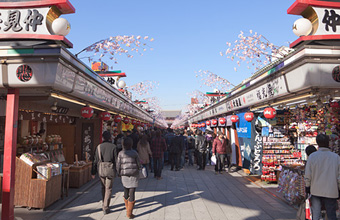
Nakamise-dori
One of the oldest shopping districts in Japan and located along the approach to Sensoji Temple.
Asakusa Nakamise-dori, which began after Tokugawa Ieyasu established the Tokugawa Shogunate, is one of the oldest shopping districts in Japan. Roughly 90 shops line both sides of the approach leading up the nearly 250 meters to Sensoji Temple’s Kaminarimon Gate. The shops sell rare souvenirs, including small articles and confectionaries with an Edo period ambiance. The area bustles with domestic and foreign tourists who are enjoying shopping, and when visitors from overseas see the seasonal, richly-Japanese ornamentation, they can’t seem to stop themselves from repeatedly exclaiming, “Wonderful!”
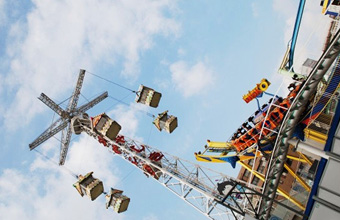
Asakusa Hanayashiki
Japan’s oldest amusement park.
Asakusa Hanayashiki, which opened in 1853 at the end of the Edo period, is the oldest amusement park in Japan.
It began as a flower garden featuring mainly peonies and works made from chrysanthemums.
The playground facilities were completed from 1872, and it was later reconstructed in 1949 as an amusement park.
Currently, the area is packed with 20 mechanical attractions, a festival plaza and restaurants, and it is well-loved for its warmth and nostalgia.
The oldest amusement park in Japan Hanayashiki. External Link
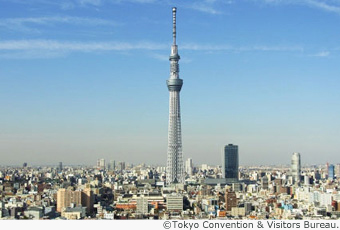
TOKYO SKYTREE®
This world-class landmark was built using ancient Japanese craftsmanship as well as state-of-the-art technologies.
At a height of 634m, this is the world’s tallest stand-alone communications tower, and it is listed in the Guinness Book of World Records™.
From the observation gallery 450m above the ground, you can enjoy an expansive view of the entire Kanto area.
The tower’s silhouette displays curves and cambers, which are often seen in traditional Japanese architecture. When lit up at night, the colorful designs call to mind images of Edo.
The tower lights beautifully shine out upon TOKYO alternating every day between a pale blue color called “iki” and an Edo-style purple color called “miyabi.”
This tower, which contains the commercial facility TOKYO Solamachi®, a planetarium and an aquarium, has become a proud, new, world-class symbol of TOKYO.
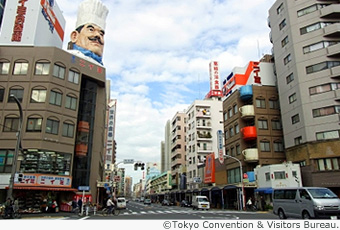
Kappabashi Kitchen Town®
This shopping area for kitchen utensils helps support the Japanese diet.
The shopping district, which specializes in dishware and cooking utensils, is situated between Asakusa and Ueno and contains roughly 170 shops along its nearly 800 meters length north to south.
The area, which began around 1912 from a small collection of utensil merchants, has more than 100 years of history.
The shopping district is a collection of kitchenware specialty shops that sell Japanese, Western and Chinese style dishware and lacquerware, kitchen equipment and utensils, food ingredients, wrapping supplies, and more.
“Food” is a deeply-rooted aspect of daily life, and it is a part of a country’s culture. Japanese cuisine was designated in 2013 as a UNESCO Intangible Cultural Heritage as the traditional dietary culture of the Japanese people.
Overseas chefs have also fallen in love with a style of Japanese knives called “wabocho.”
In recent years, realistic models of food dishes, a uniquely Japanese creation, have become popular among foreign guests, so the area has also developed as a tourist attraction.
Tokyo Kappabashi Dougu Street Promotion Union. External Link
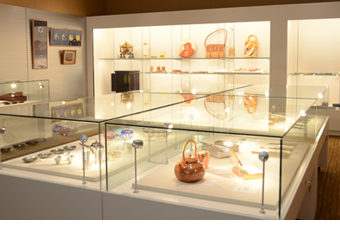
Edo Taito Traditional Crafts Center
The inherited spirit of Edo. This museum displays artistic and traditional items.
The spirit of Edo was born and passed down in the Taito Area, the origin of Edo culture and a prosperous center of commerce. This museum displays traditional crafts that shine with the spirit of Edo and the workmanship of artisans (craftsmen).
In addition to a permanent collection of 250 or more items of roughly 45 different types, including Edo-sashimono, Edo-sudare and Tokyo silverware, craftsmen manufacture products in public every Saturday and Sunday.
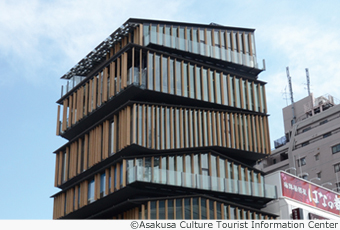
Asakusa Culture Tourist Information Center
This tourist information facility for the Taito Area is located in front of Kaminarimon Gate.
Based on the concept of “searchable, presentable, supportable,” the center provides visitors to Asakusa with useful information and services in four languages: Japanese, English, Chinese and Korean.
Please enjoy the view from the observation terrace from which visitors can see TOKYO SKYTREE and the entirety of Asakusa Town.
The center is equipped with convenient functions such as a free public wireless LAN, a foreign currency exchange counter, ticket sales services, a café room, a nursing room and an observation terrace.
Access
Directions from nearest station:

Tokyo Metropolitan Industrial Trade Center TAITO-KAN
[Address] 2-6-5 Hanakawado, Taito-ku, Tokyo, 111-0033
[TEL] 03-3844-6190
[FAX] 03-3843-6707
When coming by train
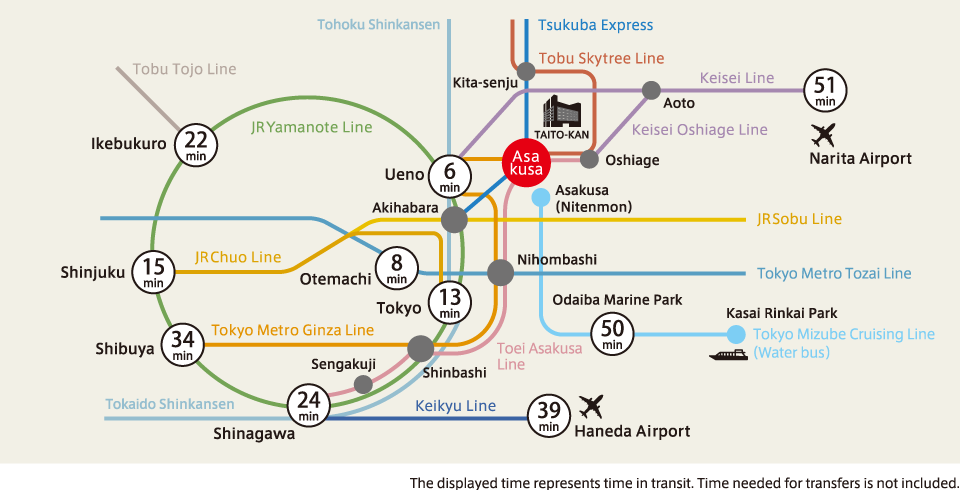
| Tokyo Metro Ginza Line |
370m from Asakusa Station. 5min on foot. Take Exit 7. Go up the stairs and leave through the left-side exit. Proceed to the right (Umamichi-dori). Located at Nitenmon Intersection. |
|---|---|
| Tobu Skytree Line |
370m from Asakusa Station. 5min on foot. Get off the escalator and leave through the right-side exit. Proceed to the right (Umamichi-dori). Located at Nitenmon Intersection. |
| Toei Asakusa Line |
500m from Asakusa Station. 8min on foot. Take Exit A5. Proceed to the left with the exit to your rear (Umamichi-dori). Located at Nitenmon Intersection. |
| Toei bus |
Directly in front after getting off at Nitenmon. (Toei 08) Nippori Station ⇔ Kinshicho Station (Kusa 64) Asakusa Kaminarimon ⇔ Ikebukuro Station East Gate |
| Tsukuba Express |
700m from Asakusa Station. 9min on foot. Take Exit A1. Proceed to the right toward Sensoji Temple. Go through the Okuyama Omairimachi Torii located at the five-way intersection and proceed straight. Pass though the precincts of Sensoji Temple. Located at Nitenmon Intersection directly across Umamichi-dori Street from Nitenmon Gate. |
| Tokyo Mizube Cruising Line (Water bus) |
500m from arrival/departure point at Asakusa (Nitenmon Gate); 6min on foot. |
When coming by car
| Highway | 5min from the Mukojima Exit on the Shuto Expressway 6 Mukojima Line. |
|---|
We do not provide a parking lot for public use. Please use a nearby parking lot when coming by car.
Click here to search for nearby parking lots.
When coming from the airport
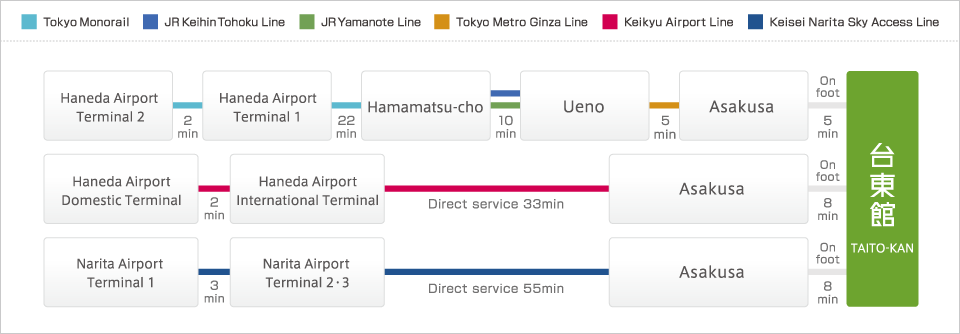
About the Center
Purpose of Establishment
The Tokyo Industrial Trade Center was established as a facility usable for trade fairs, exhibitions, etc. with the purpose of promoting commerce, industry and trade in the Tokyo Metropolitan Area.
The Center rents out exhibition halls, meeting rooms and equipment.
History
| October, 1954 | The Tokyo Metropolitan Industrial Hall – OTEMACHI-KAN opens. |
|---|---|
| November, 1969 | The Tokyo Metropolitan Industrial Hall – TAITO-KAN opens. |
| April, 1970 | The Metropolitan Trade Center, a permanent display venue, opened in order to expand overseas sales channels for products made by small and medium sized companies in the Tokyo area. |
| March, 1980 | The OTEMACHI-KAN closes due to deterioration. |
| June, 1983 | The Tokyo Metropolitan Industrial Trade Center commenced operations to centrally support the expansion of sales channels both domestically and abroad. A new annex was constructed in Minato Ward as a replacement for OTEMACHI-KAN (the Industrial Trade Center Main Building) The Industrial Hall TAITO-KAN was renamed the Industrial Trade Center TAITO-KAN. |
| April, 1998 | The Industrial Trade Center Main Building was renamed the Industrial Trade Center HAMAMATSUCHO-KAN. The incorporated foundation Tokyo Metropolitan Small and Medium Enterprise Support Center took over facility management and operation duties from the Tokyo Metropolitan Government. |
| May, 1998 | Permanent display operations at HAMAMATSUCHO-KAN discontinued. |
| October, 1998 | Usage commenced as a replacement display venue for items formerly on display at HAMAMATSUCHO-KAN. |
| April, 2006 | The incorporated foundation Tokyo Metropolitan Small and Medium Enterprise Support Center became designated by the Tokyo Metropolitan Government as the Designated Administrator of the Industrial Trade Center. |
| April, 2011 | The public interest incorporated foundation Tokyo Metropolitan Small and Medium Enterprise Support Center is designated by the Tokyo Metropolitan Government as the Designated Administrator of the Industrial Trade Center. |
| April, 2014 | As above TAITO-KAN closed for renovations. |
| April, 2015 | TTAITO-KAN reopened. |
| October, 2015 | HAMAMATSUCHO-KAN closed for reconstruction under the Urban Renovation Step-up Project (Takeshiba District). |
Overview of TAITO-KAN Facilities
The Center is a part of a common-use building occupied by the Tokyo Metropolitan Government and the Taito District.
Facility Overview
| Name | Tokyo Metropolitan Industrial Trade Center TAITO-KAN |
|---|---|
| Location | 2-6-5 Hanakawado, Taito-ku, Tokyo |
| Completion | September, 1969 |
| Structure and Scale | Steel-reinforced construction: 1 underground floor, 9 above ground floors and a 3-floored rooftop structure. |
| Architectural Area | 19,505m2 (Areas owned by Tokyo and the Taito District). Facilities related to the Center occupy 10,548m2 of this area. |
| Lot Area | 3,047m2 owned by Taito District. *The Tokyo Metropolitan Government has received permission from the District to use the land. |
| Taito District Hall related facilities in the building | Taito District Hall (a meeting and dining hall for general Taito District residence), a parking lot for sightseeing buses and the office for the Taito Chapter of the Tokyo Chamber of Commerce and Industry. |
Area and capacity of the facility
| Facility | Section | Area | Capacity | |
|---|---|---|---|---|
| Exhibition Hall | 4F | 1,495m2 | 5,836m2 | 600 people |
| 5F | 1,479m2 | 600 people | ||
| 6F | 1,479m2 | 600 people | ||
| 7F | 1,383m2 | 600 people | ||
| Conference Room | A | 67m2 | 134m2 | 35 people |
| B | 67m2 | 35 people | ||
| Shipping/Delivery area, parking lot, office, etc. | 4,578m2 | - | ||
| Total | 10,548m2 | - | ||
Designated Administrator

https://www.tokyo-kosha.or.jp/english/
The Tokyo Metropolitan Small and Medium Enterprise Support Center is a general support agency established by the Tokyo Metropolitan Government for the benefit of small and medium sized companies in the metropolitan area.
The Center provides a wide variety of services capable of dealing with all company needs. Please feel free to contact us.
FAQ
The following questions are frequently asked regarding TAITO-KAN.
Q&A relating to Access and Parking Lots
- Is there a parking lot?
-
Industrial Trade Center TAITO-KAN does not have its own parking lot.
Please use a nearby parking lot. See here for more imformation on parking lot.Area Guide
Click here for information on parking lots in the metropolitan area.※For handicap parking spaces, please contact the 3F management office.
- Is there a place to park motorbikes and bicycles?
-
We have bicycle parking areas. (Three locations on the north side of TAITO-KAN.)
However, capacity is limited, so we ask that you use nearby bicycle and vehicle parking lots.
Q&A relating to Facilities and Services
- What coping and fax services are available?
Is it possible to use the Internet? -
Please use the 3F business area.
Toll computers, copiers, printers, fax machines and mobile phone chargers are available.
An application for connection must be submitted in advance for Internet access in rented rooms (exhibition halls and meeting rooms).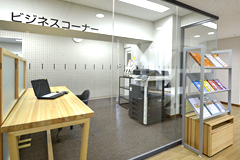
3F business area - Applications usable on toll computers.
- Internet browsing: Internet Explorer/Google chrom
- Internet-based e-mail: Multiple applications usable, including Gmail, AOL, Hotmail, Yahoo Mail, etc.
- Business software: Viewing and editing applications for Microsoft Office 13 Word, Excel and PowerPoint.
- USB usage: 1 USB port and 3 ports on the back side.
- Also avaliable: Windows Media Player, PDF file reader Adobe Reader, as well as data input and printing functions (linked to multifunction printers).
- Usage hours: 8:30-17:45
-
Usage fee: 100 yen / 10min (May be extended by inserting more coins)
※For use with 100 yen coins only. Inserted coins are not returned. No change is provided.
- Are wheelchairs available?
-
Yes, wheelchairs are available. Please inform the 3F management office if you wish to use one.
※Only a limited number are available. (Reservations not accepted.)
- What first aid facilities are available?
-
- We have installed AED (Automated External Defibrillator) devices.
AED are heart lifesaving devices that you too are able to use.
Locations: 1F guard room, 3F management office, 9F elevator hall (Taito District Hall) - An Aid Room is available on 2F.
Beds are available for use by visitors who need to temporarily lie down.
No doctors or nurses are on staff. In the case of sudden illness, we recommend that you call an ambulance and receive diagnosis at a medical institution.
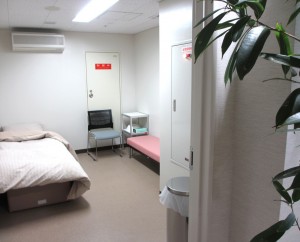
2F Aid Room - We have installed AED (Automated External Defibrillator) devices.
- Are there any restaurants?
-
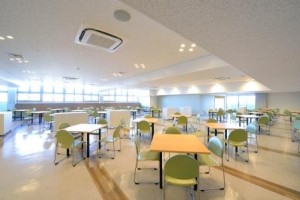
Ueno Seiyoken is located on the 8F.
Please use this restaurant, with an enjoyable view of TOKYO SKYTREE TOWER, for business discussions and meals.
It is also possible to order catering services and boxed lunches to be delivered to exhibition halls and meeting rooms. Please contact the restaurant directly if interested.Point of contact: Ueno Seiyoken, Asakusa Branch; TEL: 03-3842-0771
11:00-16:00 (LO 15:00) Closed Mondays
Seats: 144
- I seem to have dropped something. Who should I contact?
-
Please contact the management office. TEL:03-3844-6190
Items are temporarily stored in the office.
Valuables such as cash, mobile phones, credit cards, etc. are delivered to the Hanakawado Police Box on the day they are found.
Hanakawado Police Box. TEL: 03-3871-0110
- Is there a nursing room and a diaper changing room?
-
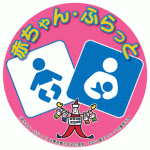

There is a Nursing and Diaper Changing Room on the 3F. Please feel free to use it.
- Are there coin lockers?
-
Free (refund-type) coin lockers are installed in the elevator halls in front of the Exhibition Halls on the 4F-7F.
Kitchenettes located in the backyards of the Exhibition Halls contain refund-type coin lockers for use by event promoters.
- Is there a cloak room?
-
Cloak rooms are available if event promoters set them up inside the venue.
For details, please contact the promoter.
Q&A relating to the Industrial Trade Center
- How earthquake resistant is TAITO-KAN?
-
The facility was built under the old seismic code, but seismic capacity evaluations identify it as complying with seismic capacity standards.
The facility bears the “seismic capacity evaluation completed” mark as designated by the Tokyo Metropolitan Area Seismic Certification Mark System.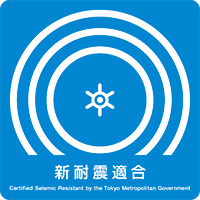
Seismic Certification Mark (seismic capacity evaluation completed)
- When are the regular holidays and business hours of the Industrial Trade Center?
-
- Open every day except facility inspection days and days on which the entire building is closed.
For inspection days and closed days, please see the information on vacancies. - Office business hours are 9:00-17:45 on weekdays and holidays.
-
Event opening times vary by promoter. Please see information regarding the event.
In some cases, event information is not publically disclosed by promoter request.
- Open every day except facility inspection days and days on which the entire building is closed.
- How handicap-accessible is the facility?
-
We take special care to ensure that those in wheelchairs are able to use elevators and toilets.
-
Wheelchair rental
Please inform the 3F management office if you wish to use one.
※Only a limited number are available. (Reservations not accepted.) - Handicap accessible elevator (one elevator)
Equipped with a low-mounted control panel, handrails on three walls and a rear mirror. - Wheelchair Accessible Toilets
Located on 1F, 8F and 9F (Taito District Hall).
-
Wheelchair rental
- Are the Industrial Trade Center and the Taito District Hall the same? Where are they located?
-
The building contains both Tokyo Metropolitan and Taito District facilities.
The Tokyo Metropolitan Industrial Trade Center (formerly known as Tokyo Metropolitan Industrial Hall) occupies 2F-7F.
The Taito District Hall and other facilities related to the Taito District occupy the 1F, 8F and 9F.
- What disaster countermeasures are in place? Where is the evacuation shelter in case of disaster?
-
Hanakawado Park, located next to the facility, serves as a temporary evacuation site.
1-14-15 Hanakawado, Taito-ku, Tokyo
View in more detail using Google MapsTAITO-KAN (referring to the entire building, including the Taito District Hall) has been designated as a property in good compliance with fire prevention measures.
(Designated on November 20 by the Nihonzutsumi Branch of the Tokyo Fire Department)
This is an acknowledgement that the facility willingly engages in complying with legal standards in order to secure a high level of safety.
Disaster drills in case of fire or earthquake are conducted twice a year in accordance with the law.
We also ask event promoters to form private firefighting teams and secure evacuation routes.